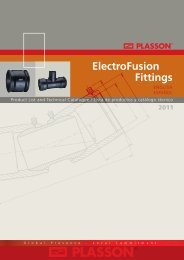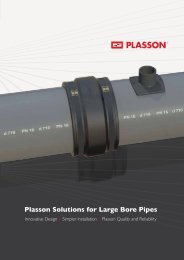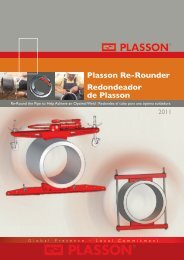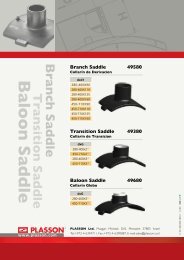Create successful ePaper yourself
Turn your PDF publications into a flip-book with our unique Google optimized e-Paper software.
<strong>Plasson</strong> <strong>Excess</strong> <strong>Flow</strong> <strong>Valve</strong><br />
Function:<br />
<strong>Plasson</strong> <strong>Excess</strong> <strong>Flow</strong> <strong>Valve</strong><br />
The <strong>Excess</strong> <strong>Flow</strong> <strong>Valve</strong> (EFV), also called Gas Stop (GS), is a special safety valve intended<br />
to be used in the house connection line of natural or other gas systems. It is typically<br />
installed at the outlet of the tapping saddle at the branch off point or on the house<br />
connection line, but can be installed at other locations and applications as well.<br />
The EFV's mechanism senses increased flow rates caused by accidental breaking of the house connection line, e.g. as a result of<br />
mistaken excavation operation or such. At normative flow rates, the EFV remains open with minimal obstruction to the gas flow, as<br />
required by the designated application. When the flow rate supersedes a preset value, the EFV automatically and immediately shuts<br />
off the outflow of gas to prevent the possibility of accidental ignition.<br />
Operation Principles:<br />
The EFV is a fully mechanical valve. Its closing body is spring biased at the open position to avoid obstruction to the flow (VN) and<br />
prevent early shutoff. In case of breakage in the downstream pipe, the flow reaches the specified closing flow (VS). The pressure<br />
difference caused by the flow at the preset closing flow rate exerts a force on the closing body greater then the spring bias, thus<br />
forcing the closing body to move towards the valve seat. Once the closing body starts to move, the balance of forces on it changes<br />
and it shuts instantly.<br />
Re-arming: After the downstream pipe is repaired, over flow (VL) creates equilibrium and the spring can move the closing body back<br />
to its original position. Thus the EFV is re-armed and ready for operation.<br />
If the EFV type is without over flow (VL), in order to rearm the EFV a manual pressure must be applied.<br />
Design Features:<br />
Fully mechanical<br />
Unique design results in very low head loss at operation flow<br />
Easy installation<br />
Components and Materials:<br />
Plastic Parts – PolyAcetal (POM-thermoplastic polymer)<br />
Rod – Stainless Steel or Brass (depending on model)<br />
Overflow Orifice - Brass<br />
Spring – Stainless Steel<br />
Seals – NBR (DIN EN 549 B2)<br />
Application<br />
In PE Gas Conducting Systems.<br />
Compliance to Standards:<br />
DVGW VP 305-2 / January 2007<br />
GDF<br />
open closed<br />
Spring<br />
Rod<br />
Seals<br />
Overflow Orifice<br />
P l a s s o n E x c e s s F l o w V a l v e<br />
3








